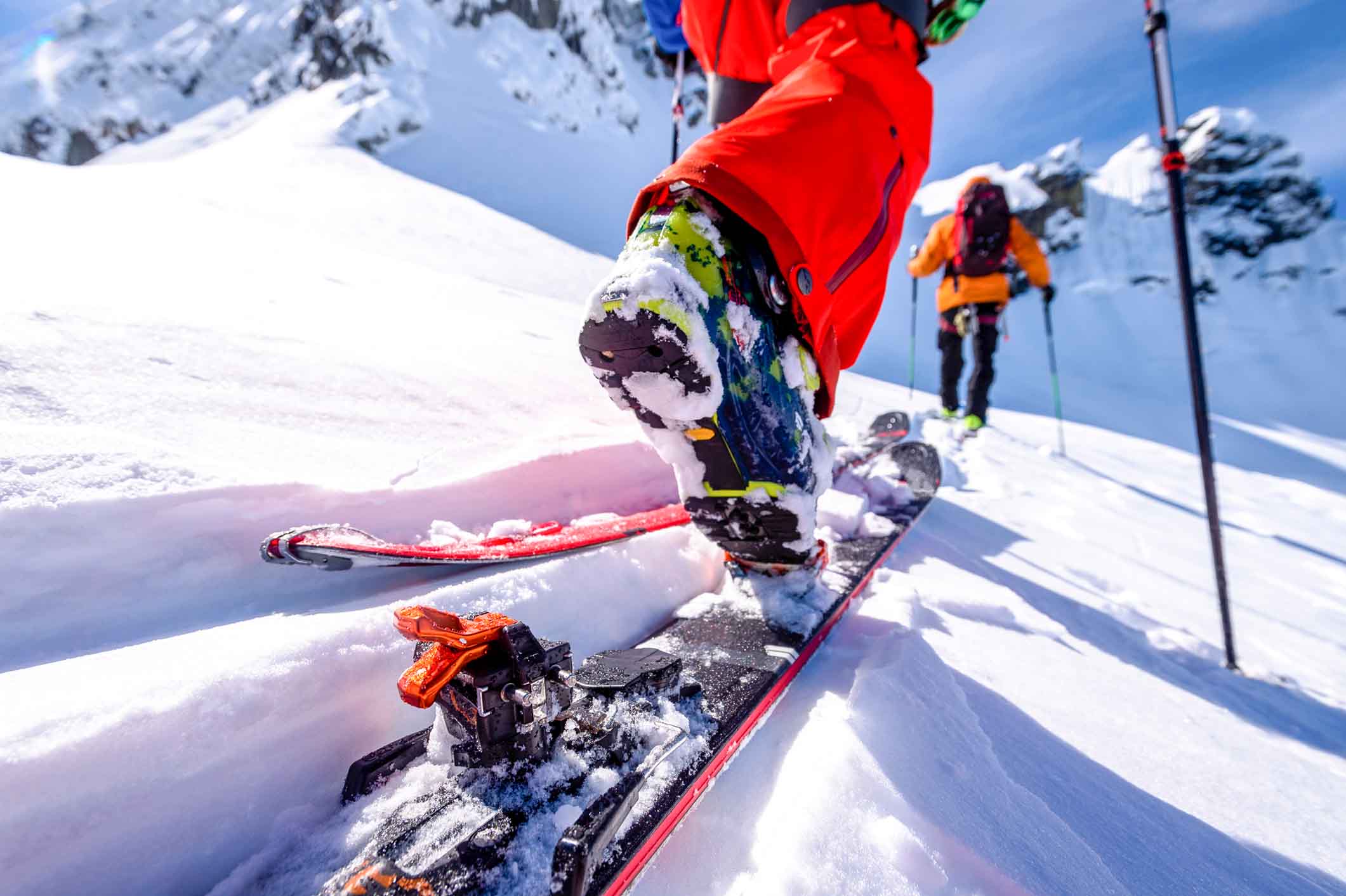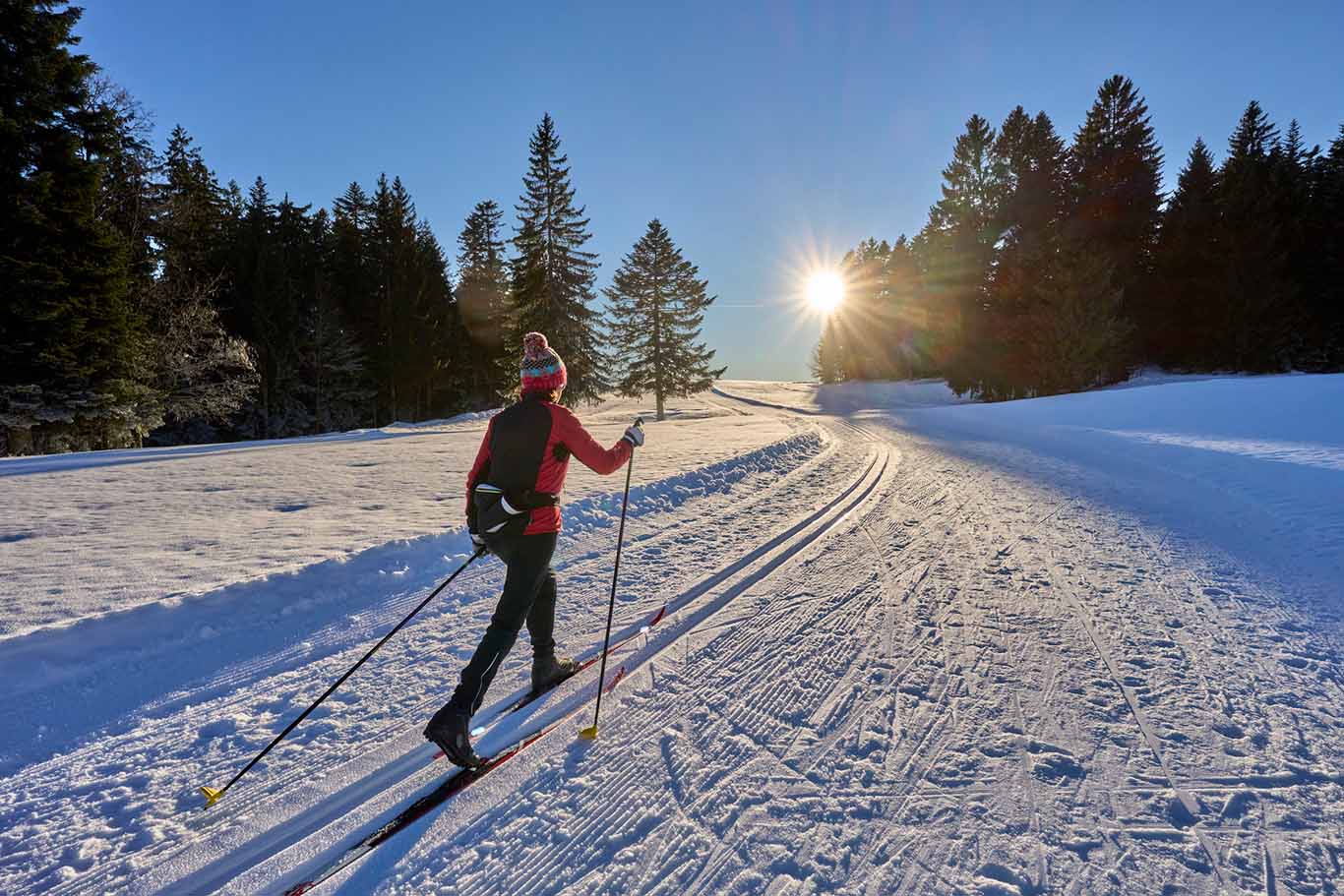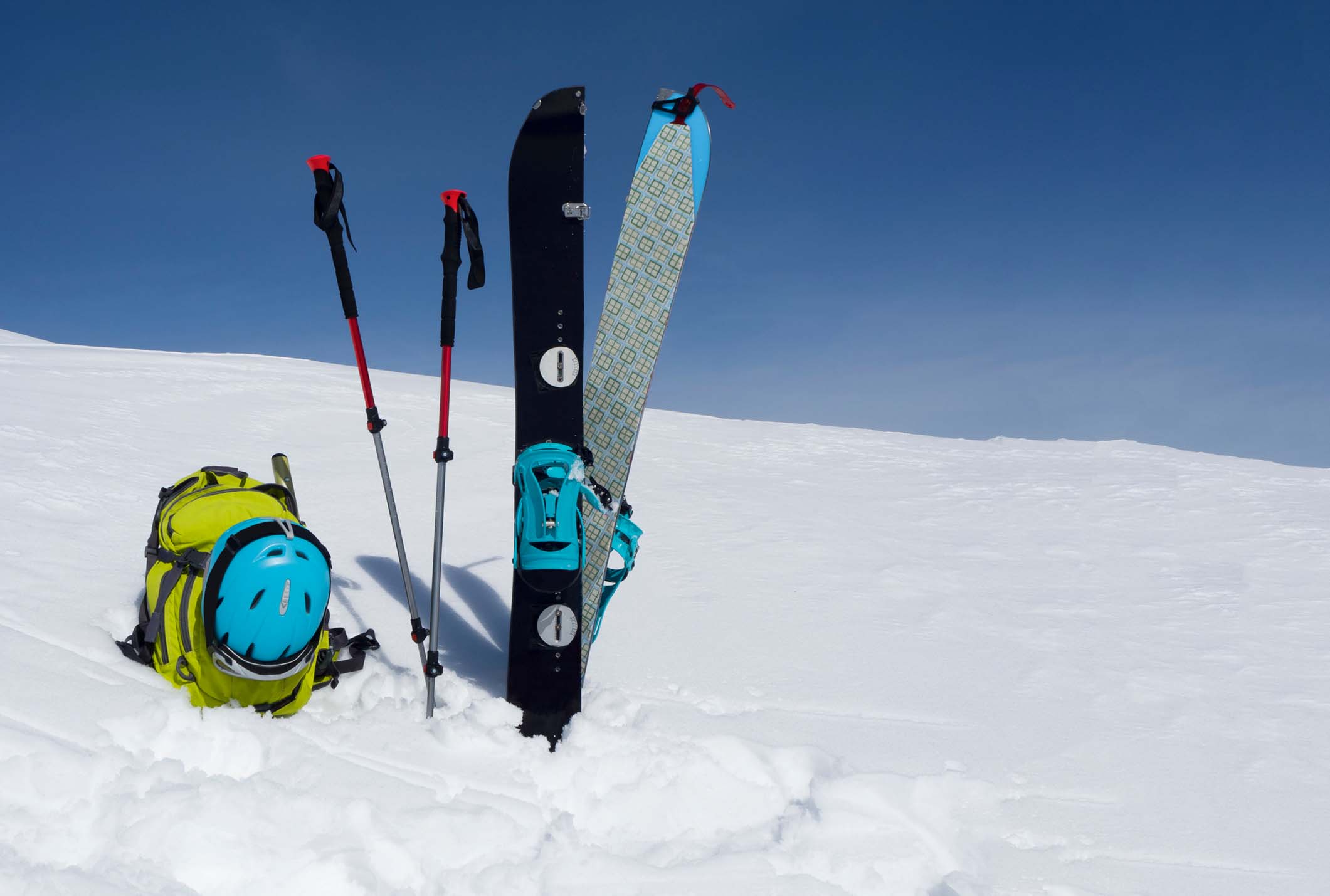When it comes to resort skiing, do you long for something a little different to push you out of your comfort zone? While the allure of groomed slopes is exciting enough for many skiers, backcountry is where the adventure lies if you’re after a more rugged, untamed experience.
There are ample opportunities for backcountry skiing in locations around the world, whether you’d prefer to stay in the UK or head overseas. There’s something for everyone too, with activities from ski touring to cross-country skiing and splitboarding.
In this comprehensive guide, we’ll explore the different types of backcountry skiing, where to go and how to get started.
What is backcountry skiing
In skiing terms, backcountry refers to unmanaged, remote natural areas where skiers venture off the beaten path for a purer, more high-risk experience. In Europe, this term is often used interchangeably with off-piste skiing, while in other areas such as North America, backcountry skiing has significant differences from off-piste skiing. There, the latter takes place in unmarked areas that are still within a ski resort, so it’s less dangerous than backcountry skiing, which is always beyond the resort’s roped-off confines.
Wherever you go, backcountry skiing gives you a more raw, immersive and exhilarating experience in the great outdoors. However, it requires a higher level of safety awareness, confidence and experience, due to it being outside of resort boundaries and unmonitored by authorities.

Ski touring: an overview
Ski touring, also known as alpine touring, involves skiing uphill using specialised bindings that allow the heel to lift. Skiers use skins on the base of their skis for traction, so you have more freedom in where you can ski without having to rely on a lift or flat tracks. This form of skiing caters to thrill-seekers who crave fresh powder that others can’t reach, and the challenge of ascending slopes by themselves.
Where are the best places to go ski touring?
You can find rugged playgrounds for ski touring as close as Scotland, or venture a little further to France, Italy, and other European countries. Beyond Europe, the world is dotted with destinations where you can get your fix of uphill challenges and rewarding downhill descents. These include the iconic slopes of South America, the vast wilderness of North America and the stunning panoramas of New Zealand.
Read more about the best places to go ski touring.
The UK
The Scottish Highlands stand out as the premier destination for ski touring in the UK, with areas like Glencoe, Ben Nevis, and the Cairngorms offering ideal conditions. These regions will please ski tourers of all skill levels, with majestic landscapes and substantial snowfall.
Europe
Europe boasts numerous ski touring destinations that stand out as a mecca for this sport. They include:
France – Chamonix-Mont-Blanc has iconic routes and breathtaking views.
Switzerland – the Jungfrau mountain, in the Bernese Alps, combines the thrill of the journey with memorable high-altitude vantage points.
Italy – the Dolomites impress with their jagged peaks and diverse routes.
Norway – the Lyngen Alps offer a unique Arctic experience.
Austria – the Austrian Alps have a blend of adrenaline-pumping ascents and rewarding descents.
Rest of the world
Beyond Europe, the rest of the world offers enticing ski touring far and wide, for adventure on a global scale. Hotspots include:
North America – the Canadian Rockies, especially Banff and Jasper National Parks, consist of stunning backcountry routes. Unparalleled wilderness adventures can also be found in Alaska’s Chugach Mountains.
South America – the Andes tower above many other areas for ancient thrills, particularly in Chile’s Santiago and Argentina’s Patagonia.
Japan – Hokkaido and the Daisetsuzan Range attract skiers with deep powder and cultural richness.
Australia – unique skiing can be found in the Snowy Mountains, with peaks like Mount Kosciuszko, the highest in Australia.
New Zealand – the Southern Alps, stretching across the South Island, feature towering peaks, expansive glaciers, and pristine backcountry snow.

Cross-country skiing: an overview
Cross-country skiing, also referred to as Nordic skiing, involves gliding over snow-covered terrain using long and narrow skis. Unlike downhill skiing, cross-country skiing focuses on horizontal travel, emphasising endurance, cardiovascular fitness, and full-body engagement. Skiers propel themselves forward on flat or gently rolling terrain, using skis equipped with a free-heel binding. It’s beloved for its accessibility and scenic routes.
Where are the best places to go cross-country skiing?
You can participate in cross-country skiing in the UK, if you go to the right places. However, if you want to take a trip abroad, there’s plenty on offer, from the immaculate trails of the Nordic countries to the panoramic beauty of the Canadian Rockies and the Southern Hemisphere’s hidden gems.
Here’s an overview of the best cross-country skiing locations worldwide.
The UK
Cross-country skiing in the UK is, again, primarily enjoyed in the Scottish Highlands. Aviemore, within the Cairngorms National Park, offers excellent trails for cross-country skiers. The Glenmore Forest Park and nearby Rothiemurchus Estate have well-maintained tracks within stunning Highland scenery. The Lecht Ski Centre, also in the Cairngorms, caters to cross-country skiers with a range of trails suitable for different skill levels.
Europe
Europe offers an array of cross-country skiing utopias. They include:
Norway – the renowned Nordmarka and Sjusjøen regions have extensive networks through picturesque forests.
Sweden – the Idre Fjäll and Åre showcase unspoiled trails with panoramic views.
Finland – Lapland, especially in Levi and Ylläs, is a winter wonderland that needs no introduction.
Italy – the Dolomites, specifically in Alta Badia, feature challenging routes amid astonishing panoramas.
France – the Jura Mountains boast well-groomed tracks in areas like Les Rousses.
Switzerland – the Engadin Valley is renowned for hosting the prestigious Engadin Skimarathon.
Germany – the Black Forest, or Schwarzwald, provides charming trails, particularly around the Black Forest National Park, Titisee and Feldberg.
Rest of the world
Outside of Europe, cross-country skiers can choose from a rich tapestry of international cross-country skiing experiences. Locations include:
North America – Washington State’s Methow Valley has a far-reaching network of trails, while Vermont’s Craftsbury Outdoor Center is another strong choice. Canada’s Lake Louise and Whistler Olympic Park are also world-class destinations.
Japan – the Niseko region combines cross-country skiing with the allure of Japanese culture.
Australia – Falls Creek and Perisher in the Snowy Mountains are particularly favoured by cross-country skiers.
New Zealand – enjoy spectacular Southern Alps panoramas at the Snow Farm in Wanaka.

Splitboarding: an overview
Splitboarding is the snowboarder’s answer to ski touring, with the same benefits of versatility and access to untouched backcountry powder. The snowboard splits into two separate skis for ascending, then reattaches for descending. It offers the best of both worlds for those who revel in downhill snowboarding and the challenge of uphill climbing.
Where are the best places to go splitboarding?
While the UK and Europe have plenty of good spots for splitboarding, from Scotland to Switzerland and Austria, you can find highly-revered locations further afield too. From North America’s rugged mountains and Japan’s deep powder to the Southern Hemisphere’s snow-covered landscapes, splitboarding opens up a global playground.
Here’s a guide to the best places to go splitboarding.
The UK
Once again, areas like Glencoe, Ben Nevis, and Cairngorms National Park in the Scottish Highlands are the perfect settings. These regions have no shortage of snowfall (the latter is the snowiest place in the UK), so they offer first-rate splitboarding without having to leave our shores.
Europe
There are fantastic opportunities for splitboarding adventures in Europe. These destinations have a mix of challenging ascents, spotless snow conditions, and magical backdrops, for a truly memorable backcountry experience.
They include:
Switzerland – the Alps, especially around Verbier and Zermatt, provide awesome backcountry conditions.
France – Chamonix-Mont-Blanc boasts iconic routes with challenging descents.
Italy – the Aosta Valley, near Courmayeur, incorporates diverse surroundings for splitboarders.
Austria – the Arlberg region, including St. Anton, combines beautiful scenery with thrilling descents.
Norway – the Lyngen Alps are home to unique Arctic splitboarding.
Spain – Baqueira-Beret, in the Spanish Pyrenees, is made up of an untouched backcountry paradise.
Andorra – also in the Pyrenees, Grandvalira has vast options for splitboarders of all levels, from sweeping bowls to tree-lined glades and steep chutes.
Rest of the world
Beyond Europe, other spectacular splitboarding destinations include:
North America – the vast backcountry of British Columbia, Canada, particularly around Revelstoke and Whistler, provides epic descents.
The U.S. – Central America offers many different options, with Colorado’s Rocky Mountains, Alaska’s Chugach Range, and Wyoming’s Tetons standing out.
Japan – Hokkaido has consistent winter conditions right through to April, along with idyllic backcountry expanses.
New Zealand – particularly breathtaking are the Southern Alps, especially around Queenstown.
Chile – the Chilean Central Andes cater to splitboarders of all levels, with diverse alpine bowls, and couloirs around Santiago.
Australia – the Snowy Mountains National Park is a fan favourite for splitboarders during the winter season of June to October.

How to prepare for backcountry skiing
Becoming a proficient backcountry skier involves a combination of skill development, knowledge acquisition, and a commitment to safety. Here are some essential areas you should look to focus on to prepare yourself and grow your abilities.
Develop your skills
Build a solid foundation of skiing skills on groomed slopes. This includes mastering turns, controlling speed, and confidently navigating various types of territory. Begin with day tours in well-known and well-travelled backcountry areas. Choose routes that match your skill level, gradually increasing difficulty as you gain experience.
Invest time into educating yourself
Take avalanche safety courses, keep learning and regularly update your knowledge. Build your map-reading and GPS skills, carry a first-aid kit and know basic first-aid procedures. Be familiar with emergency protocols and communication devices. Share your backcountry plans with someone reliable, and always ski with a partner. You should also practise Leave No Trace principles by minimising your impact on the environment. Stay on established trails, make as little noise as possible, and respect wildlife.
Refine your techniques
Practise uphill techniques for significant upward travel, particularly for ski touring. Make sure you know how to skin efficiently, and use climbing aids on your bindings. Focus on conserving energy during ascents, maintaining a consistent and sustainable pace. You could join guided backcountry tours or go skiing with experienced friends. Learning from people with more experience can give you valuable insights into route selection, decision-making processes, and overall backcountry etiquette.
Develop your physical fitness
Regularly participate in fitness activities that target the muscles used in skiing and snowboarding. These could include cycling and running for cardiovascular conditioning; leg exercises such as squats, lunges and box jumps; and core exercises such as planks and Russian twists. Flexibility training such as yoga and dynamic stretches will also be valuable.
Familiarise yourself with your gear
Of course, you’ll also need to obtain and become comfortable with the appropriate backcountry skiing gear. Make sure you know which backcountry skiing gear to obtain, and how to use it. This includes:
Touring skis and bindings: Check for any damage and make sure your bindings are properly adjusted.
Climbing skins: Inspect for wear and tear, and confirm that they attach securely to your skis.
Avalanche safety gear: Your beacon will need to have fresh batteries, and you can practise using your probe and shovel.
Clothing: Dress in layers suitable for changing weather conditions. Waterproofs and breathable outer layers are essential.
Get winter sports insurance with SportsCover Direct
Indulging in high-octane activities comes with its risks, so you’ll need to take the appropriate measures to protect yourself as much as possible. Getting the right insurance is essential before you set out backcountry skiing, so that you can focus on staying safe and enjoying your sport.
Choose from three policy options with SportsCover Direct’s winter sports insurance. Whether you’re off-piste skiing, ski touring or cross-country skiing, we offer cover for trip cancellation, medical costs, income protection and more, in the UK or abroad. Alternatively if you fancy a snowboarding trip, we offer a comprehensive snowboarding insurance.
Read more and get a quote online.
This blog has been created as general information and should not be taken as advice. Make sure you have the correct level of insurance for your requirements and always review policy documentation.